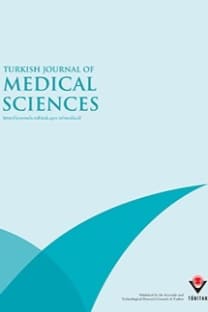Prevalence of Helicobacter pylori infection in healthcare workers
Key words: Helicobacter pylori, serology, Zahedan
Prevalence of Helicobacter pylori infection in healthcare workers
Key words: Helicobacter pylori, serology, Zahedan,
___
- Triantafillidis JK, Gikas A, Hyphantis T, Cheracakis P, Rokkas T, Konstantellou E, et al. Helicobacter pylori infection in hospital workers over a 5-year period: correlation with demographic and clinical parameters. J Gastroenterol. 2002; 37: 1005-13.
- Monno R, Volpe A, Basho M, Fumarula L, Trerotoli P, Kondili LA et al. Helicobacter pylori seroprevalence in selected groups of Albanian volunteers. Infection 2008; 36: 345-50.
- Von Wulffen H. An assessment of serological tests for detection of Helicobacter pylori. Eur J Clin Microbial Infect Dis 1992; 11: 577-582.
- Pounder RF, Ng D. The prevalence of Helicobacter pylori infection in different countries. Aliment Pharmacol Therapeut 1995; 9: 33-39.
- Nurgalieva ZZ, Malaty HM, Graham DY, Almuchambetova R, Machmudova A, Kapsultanova D et al. Helicobacter pylori infection in Kazakhstan: Effect of water source and household hygiene. Am J Trop Med Hyg 2002; 67: 201-206.
- Lin DB. Seroepidemiology of Helicobacter pylori infection among preschool children in Taiwan. Am J. Trop Med Hyg 1999; 61: 554-558.
- Moradi A, Rashidi PA. Seroepidemiologic study of Helicobacter pylori infection in Semnsn, Iran in 1999. Journal of Medical University of Semnan 1999; 1: 45-49
- Babamahmoodi F, Ajemi A, Kalhor M, Shfiei GhR, Khalilian AR. Seroepidemiologic study of infection with Helicobacter pylori in Sari, Iran in 2001-02. Journal of Mazandaran University of Medical Sciences. 2003; 14: 39-47.
- Farhadi A, Bahar A, Kowsarian M, Mahdavi M. Seroepidemiologic study of Helicobacter pylori infection in children aged 7-18 in Sari, Iran in 1999. Journal of Mazandaran University of Medical Sciences, 2000; 10: 19-25
- Weiss J, Mecca J, Silva E, Gassner D. Comparison of PCR and other diagnostic techniques for detection of Helicobacter pylori infection in dyspeptic patients. J Clin Microbiol 1994; 32: 1663- 1668.
- Agresti, A. An introduction to categorical data analysis. John Wiley & Sons, New York. 1996; 31-32.
- Zahedi MJ, Darvish Moghadam S, Atapour M, Jahanbakhsh Absasi M. Relative frequency of Helicobacter pylori infection in patients referring to health centers in 2000, in Kerman, Iran. Journal of Medical University of Kerman 2000; 3: 140-144
- Suerbaum S, Michetti P. Helicobacter pylori infection. NEJM 2002; 347: 1175-1186.
- ISSN: 1300-0144
- Yayın Aralığı: 6
- Yayıncı: TÜBİTAK
Füsun EROĞLU, Şenol GÜLMEN, Ömer Rıdvan TARHAN, Lütfi YAVUZ, Berit Gökçe CEYLAN, Adnan ALACA
Azim HONARMAND, Mohammadreza SAFAVI, Daruosh MORADI, Saeid ABRISHAMKAR, Pouria TAVAKOLI
Nesrin HASIRCI, Bilge Hakan ŞEN, Tuba ENDOĞAN, Gülçe Sultan İZ, Delioğlu Saime İsmet GÜRHAN
Atypical clinical manifestation of dementia: a progressive visuospatial deficit
Hakan TEKELİ, Mehmet SARAÇOĞLU, Erdem TOĞROL, Mehmet Güney ŞENOL
Incidence and risk factors for bloodstream infections stemming from temporary hemodialysis catheters
Gürdal YILMAZ, Kemalettin AYDIN, Rahmet ÇAYLAN, İftihar KÖKSAL, Ebru Emel SÖZEN
Dermatoglyphics as markers of prenatal disturbances in schizophrenia: a case-control study
Birsen ÖZYURT, Ahmet SONGUR, Reha DEMİREL, Mustafa NAMLI, Ömer AKYOL, Mustafa SARSILMAZ
Ali Pekcan DEMİRÖZ, Rukiye BERKEM, Tuncer Günay ERTEM, Ataman Çiğdem HATİPOĞLU, Ferah ERGİN, Cemal BULUT
Evaluation of oxidant/antioxidant status and ECP levels in asthma
Ömer EMECEN, Murat USTA, Hale ARAL, Berçik Berrin İNAL, Güvenç GÜVENEN, Füsun ERDENEN
Histomorphometric study on the effect of low dose deltamethrin on the developing cerebellar cortex
Mohd Asnizam ASARI, Mokammad Shukri ABDULLAH, Zul Izhar Mohd ISMAIL
